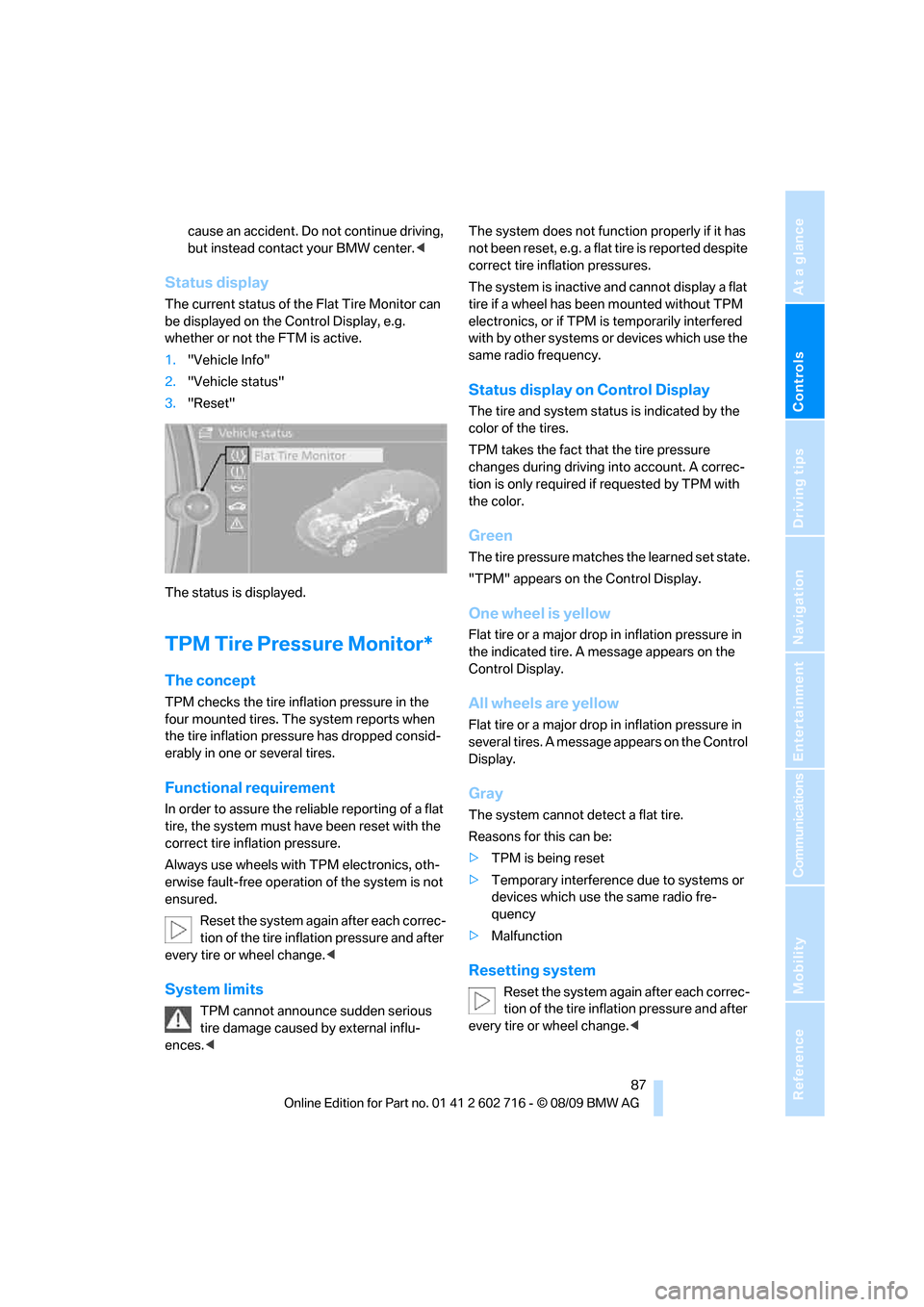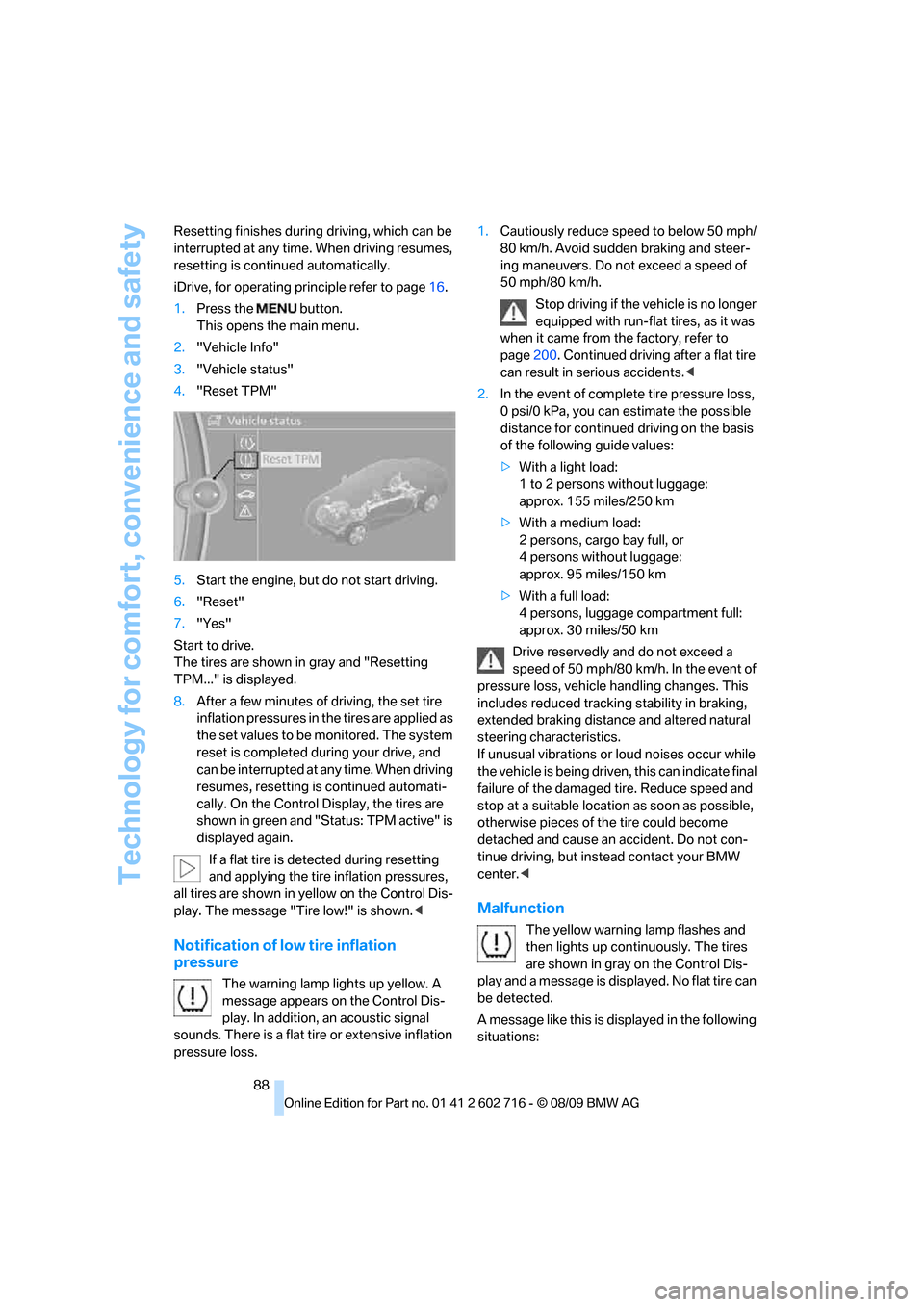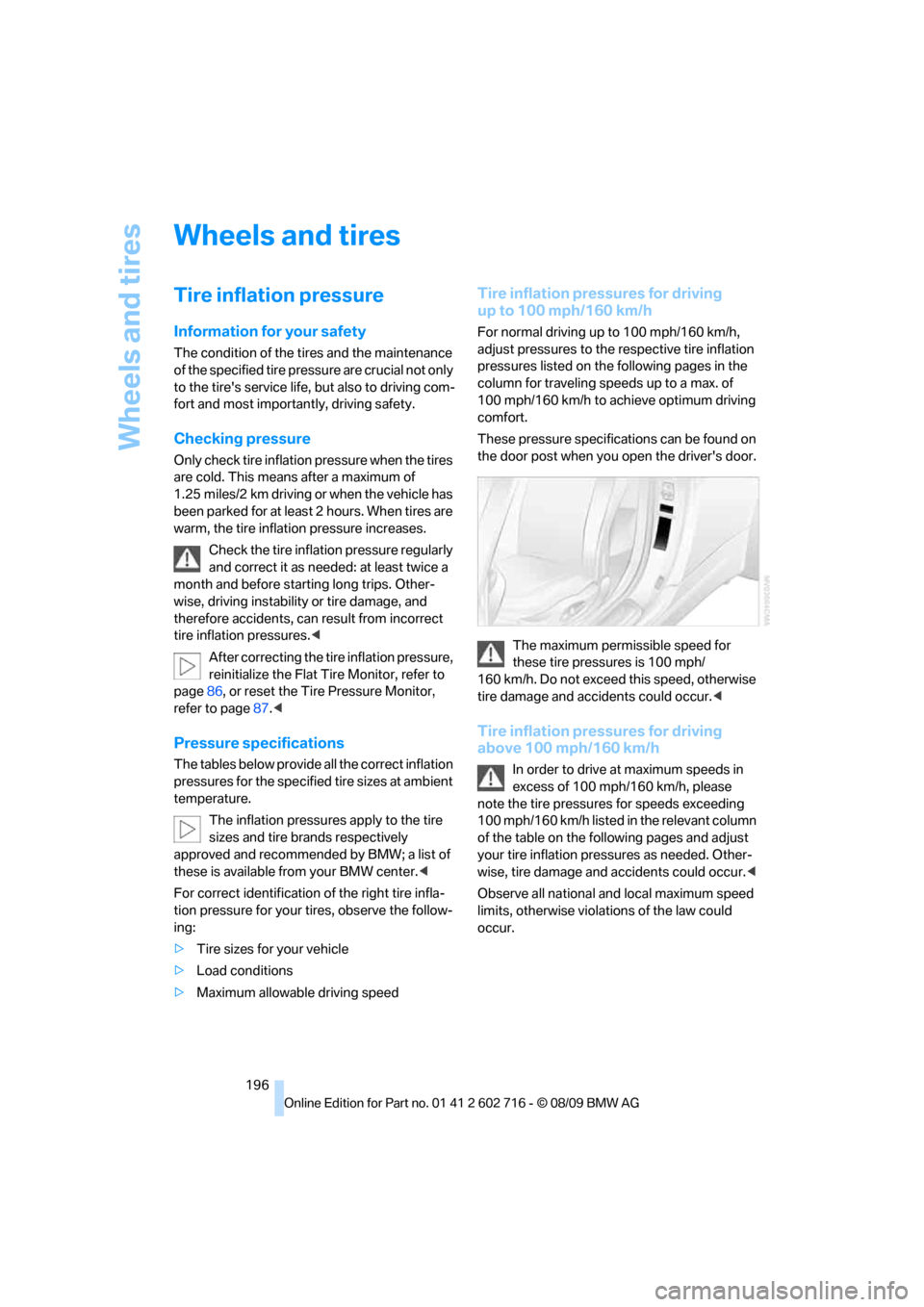2010 BMW 650I COUPE tire pressure reset
[x] Cancel search: tire pressure resetPage 88 of 252

Technology for comfort, convenience and safety
86 >Sporty driving style: slip in the drive wheels,
high lateral acceleration
>Driving with snow chains
*
Initializing system
The initialization finishes during driving,
which can be interrupted at any time.
When driving resumes, the initialization is con-
tinued automatically. The system is initialized
after this activation phase.
The initialization process adopts the set infla-
tion tire pressures as reference values for the
detection of a flat tire. Initialization is started by
confirming the inflation pressures.
The system is not initialized when traveling with
snow chains
*.<
iDrive, for operating principle refer to page16.
1."Vehicle Info"
2."Vehicle status"
3."Reset"
4.Start the engine - do not drive away.
5.Start the initialization using "Reset".
"Activating…" is displayed on the Control
Display.
6.Start to drive.
The initialization finishes during driving, which
can be interrupted at any time. "Flat Tire Moni-
tor active" is displayed on the Control Display.
Indication of a flat tire
The warning lamp lights up red. A mes-
sage appears on the Control Display.
In addition, an acoustic signal sounds.
There is a flat tire or extensive inflation pressure
loss.1.Cautiously reduce the vehicle speed to
below 50 mph/80 km/h. Avoid severe brak-
ing and steering maneuvers and do not
exceed a speed of 50 mph/80 km/h.
Stop driving if the vehicle is no longer
equipped with run-flat tires, as it was
when it came from the factory, refer to
page200. Continued driving after a flat tire
can result in serious accidents.<
2.At the next opportunity, check the air pres-
sure in all four tires.
If the tire inflation pressure in all four
tires is correct, the Flat Tire Monitor
may not have been initialized. The system
must then be initialized.<
3.In the event of complete tire pressure loss,
0 psi/0 kPa, you can estimate the possible
distance for continued driving on the basis
of the following guide values:
>With a light load:
1 to 2 persons without luggage:
approx. 155 miles/250 km
>With a medium load:
2 persons, cargo bay full, or
4 persons without luggage:
approx. 94 miles/150 km
>With a full load:
4 persons, luggage compartment full:
approx. 30 miles/50 km
Drive reservedly and do not exceed a
speed of 50 mph/80 km/h. In the
event of pressure loss, vehicle handling
changes. This includes reduced tracking
stability in braking, extended braking dis-
tance and altered natural steering charac-
teristics.
When towing a trailer, heavy trailers in par-
ticular can begin to swing back and forth.
Therefore, do not exceed 35 mph/60 km/h,
otherwise there is the danger of an acci-
dent.
If unusual vibrations or loud noises occur
while the vehicle is being driven, this can
indicate final failure of the damaged tire.
Reduce speed and stop at a suitable loca-
tion as soon as possible, otherwise pieces
of the tire could become detached and
Page 89 of 252

Controls
87Reference
At a glance
Driving tips
Communications
Navigation
Entertainment
Mobility
cause an accident. Do not continue driving,
but instead contact your BMW center.<
Status display
The current status of the Flat Tire Monitor can
be displayed on the Control Display, e.g.
whether or not the FTM is active.
1."Vehicle Info"
2."Vehicle status"
3."Reset"
The status is displayed.
TPM Tire Pressure Monitor*
The concept
TPM checks the tire inflation pressure in the
four mounted tires. The system reports when
the tire inflation pressure has dropped consid-
erably in one or several tires.
Functional requirement
In order to assure the reliable reporting of a flat
tire, the system must have been reset with the
correct tire inflation pressure.
Always use wheels with TPM electronics, oth-
erwise fault-free operation of the system is not
ensured.
Reset the system again after each correc-
tion of the tire inflation pressure and after
every tire or wheel change.<
System limits
TPM cannot announce sudden serious
tire damage caused by external influ-
ences.
correct tire inflation pressures.
The system is inactive and cannot display a flat
tire if a wheel has been mounted without TPM
electronics, or if TPM is temporarily interfered
with by other systems or devices which use the
same radio frequency.
Status display on Control Display
The tire and system status is indicated by the
color of the tires.
TPM takes the fact that the tire pressure
changes during driving into account. A correc-
tion is only required if requested by TPM with
the color.
Green
The tire pressure matches the learned set state.
"TPM" appears on the Control Display.
One wheel is yellow
Flat tire or a major drop in inflation pressure in
the indicated tire. A message appears on the
Control Display.
All wheels are yellow
Flat tire or a major drop in inflation pressure in
several tires. A message appears on the Control
Display.
Gray
The system cannot detect a flat tire.
Reasons for this can be:
>TPM is being reset
>Temporary interference due to systems or
devices which use the same radio fre-
quency
>Malfunction
Resetting system
Reset the system again after each correc-
tion of the tire inflation pressure and after
every tire or wheel change.<
Page 90 of 252

Technology for comfort, convenience and safety
88 Resetting finishes during driving, which can be
interrupted at any time. When driving resumes,
resetting is continued automatically.
iDrive, for operating principle refer to page16.
1.Press the button.
This opens the main menu.
2."Vehicle Info"
3."Vehicle status"
4."Reset TPM"
5.Start the engine, but do not start driving.
6."Reset"
7."Yes"
Start to drive.
The tires are shown in gray and "Resetting
TPM..." is displayed.
8.After a few minutes of driving, the set tire
inflation pressures in the tires are applied as
the set values to be monitored. The system
reset is completed during your drive, and
can be interrupted at any time. When driving
resumes, resetting is continued automati-
cally. On the Control Display, the tires are
shown in green and "Status: TPM active" is
displayed again.
If a flat tire is detected during resetting
and applying the tire inflation pressures,
all tires are shown in yellow on the Control Dis-
play. The message "Tire low!" is shown.<
Notification of low tire inflation
pressure
The warning lamp lights up yellow. A
message appears on the Control Dis-
play. In addition, an acoustic signal
sounds. There is a flat tire or extensive inflation
pressure loss.1.Cautiously reduce speed to below 50 mph/
80 km/h. Avoid sudden braking and steer-
ing maneuvers. Do not exceed a speed of
50 mph/80 km/h.
Stop driving if the vehicle is no longer
equipped with run-flat tires, as it was
when it came from the factory, refer to
page200. Continued driving after a flat tire
can result in serious accidents.<
2.In the event of complete tire pressure loss,
0 psi/0 kPa, you can estimate the possible
distance for continued driving on the basis
of the following guide values:
>With a light load:
1 to 2 persons without luggage:
approx. 155 miles/250 km
>With a medium load:
2 persons, cargo bay full, or
4 persons without luggage:
approx. 95 miles/150 km
>With a full load:
4 persons, luggage compartment full:
approx. 30 miles/50 km
Drive reservedly and do not exceed a
speed of 50 mph/80 km/h. In the event of
pressure loss, vehicle handling changes. This
includes reduced tracking stability in braking,
extended braking distance and altered natural
steering characteristics.
If unusual vibrations or loud noises occur while
the vehicle is being driven, this can indicate final
failure of the damaged tire. Reduce speed and
stop at a suitable location as soon as possible,
otherwise pieces of the tire could become
detached and cause an accident. Do not con-
tinue driving, but instead contact your BMW
center.<
Malfunction
The yellow warning lamp flashes and
then lights up continuously. The tires
are shown in gray on the Control Dis-
play and a message is displayed. No flat tire can
be detected.
A message like this is displayed in the following
situations:
Page 198 of 252

Wheels and tires
196
Wheels and tires
Tire inflation pressure
Information for your safety
The condition of the tires and the maintenance
of the specified tire pressure are crucial not only
to the tire's service life, but also to driving com-
fort and most importantly, driving safety.
Checking pressure
Only check tire inflation pressure when the tires
are cold. This means after a maximum of
1.25 miles/2 km driving or when the vehicle has
been parked for at least 2 hours. When tires are
warm, the tire inflation pressure increases.
Check the tire inflation pressure regularly
and correct it as needed: at least twice a
month and before starting long trips. Other-
wise, driving instability or tire damage, and
therefore accidents, can result from incorrect
tire inflation pressures.<
After correcting the tire inflation pressure,
reinitialize the Flat Tire Monitor, refer to
page86, or reset the Tire Pressure Monitor,
refer to page87.<
Pressure specifications
The tables below provide all the correct inflation
pressures for the specified tire sizes at ambient
temperature.
The inflation pressures apply to the tire
sizes and tire brands respectively
approved and recommended by BMW; a list of
these is available from your BMW center.<
For correct identification of the right tire infla-
tion pressure for your tires, observe the follow-
ing:
>Tire sizes for your vehicle
>Load conditions
>Maximum allowable driving speed
Tire inflation pressures for driving
up to 100 mph/160 km/h
For normal driving up to 100 mph/160 km/h,
adjust pressures to the respective tire inflation
pressures listed on the following pages in the
column for traveling speeds up to a max. of
100 mph/160 km/h to achieve optimum driving
comfort.
These pressure specifications can be found on
the door post when you open the driver's door.
The maximum permissible speed for
these tire pressures is 100 mph/
160 km/h. Do not exceed this speed, otherwise
tire damage and accidents could occur.<
Tire inflation pressures for driving
above 100 mph/160 km/h
In order to drive at maximum speeds in
excess of 100 mph/160 km/h, please
note the tire pressures for speeds exceeding
100 mph/160 km/h listed in the relevant column
of the table on the following pages and adjust
your tire inflation pressures as needed. Other-
wise, tire damage and accidents could occur.<
Observe all national and local maximum speed
limits, otherwise violations of the law could
occur.
Page 246 of 252

Everything from A to Z
244 Protective function, refer to
Pinch protection system
– glass sunroof38
– windows37
R
Radio
– controls146
– HD Radio150
– satellite radio152
– selecting waveband149
– storing stations150
– switching on/off146
– tone control146
– volume146
– weatherband, refer to
Weather news flashes151
Radio key, refer to Keys/
remote control26
Radio position, refer to Radio
readiness56
Radio readiness56
– switched off57
– switched on56
– with Comfort Access35
Rain sensor, windshield wiper
system62
Random sequence
– external devices168
– music collection164
Reading lamps102
Rear lamps, refer to Tail
lamps213
Rearview mirrors, refer to
Mirrors51
Rear window
– heating105
– opening and closing37
Reception
– quality150
– radio stations150
Recirculated-air mode, refer
to AUC Automatic
recirculated-air control105
Recirculation of air, refer to
AUC Automatic
recirculated-air control105Reclining seat, refer to
Seats45
Reflectors, refer to Tail
lamps213
Refueling194
Releasing
– hood202
Releasing the locks, refer to
Unlocking34
Remaining distance, refer to
Cruising range73
Remaining distance to
destination, refer to
Computer74
Remote control26
– Comfort Access34
– garage door opener109
– luggage compartment lid28
– malfunction29,35
– replacing battery35
Removing condensation on
the windows105
Replacement fuses215
Replacement of tires
– refer to Changing
wheels214
Replacement remote control,
refer to New remote
controls26
Replacing bulbs, refer to
Lamps and bulbs212
Replacing wheels/tires, refer
to New wheels and tires200
Reporting safety defects7
Required fuel195
Reserve
– warning, refer to Fuel
gauge73
Reset, refer to Resetting tone
settings148
Residual heat106
Restraint systems
– for children53
– refer to Safety belts50
Retreaded tires200
Reverse
– CD changer156
– CD player156Reverse gear
– manual transmission58
– Sport automatic
transmission59
Road map138
Roadside
Assistance187,217
Roadside parking lamps100
– replacing bulbs, refer to
Parking lamps213
Rollover protection system on
Convertible92
– lowering92
Rope, refer to Tow-starting
and towing218
Rotary/pushbutton, refer to
iDrive16
Route136,137
– bypassing sections137
– changing136,137
– changing criteria136
– displaying map view138
– displaying streets or towns/
cities137
– selecting136
Route information, refer to
Destination guidance with
voice instructions137
Route map, refer to Displaying
map view138
Route selection136
RSC Runflat System
Component, refer to Run-
flat tires200
Run-flat System Component
RSC, refer to Run-flat
tires200
Run-flat tires200
– continuing driving with a
damaged tire86,88
– flat tire86,88
– Flat Tire Monitor85
– tire inflation pressure196
– Tire Pressure Monitor87
– tire replacement200,201
– winter tires201
Page 249 of 252

Reference 247
At a glance
Controls
Driving tips
Communications
Navigation
Entertainment
Mobility
Tire replacement
– new wheels and tires200
Tires
– age198
– air loss86,88
– breaking-in118
– condition199
– damage199
– inflation pressure196
– minimum tread depth199
– new wheels and tires200
– pressure monitoring, refer to
Flat Tire Monitor85
– pressure monitoring, refer to
Tire Pressure Monitor87
– replacing200
– retreaded tires200
– run-flat tires200
– size197
– size, refer to The right
wheels and tires200
– wear indicators199
– wheel/tire combination200
– winter tires201
Tires with run-flat properties
– refer to Run-flat tires200
TMC station, refer to Traffic
information139
Tone
– control146
– middle setting148
Tone on locking/unlocking29
Tools, refer to Onboard
vehicle tool kit212
Top39
Top 50 of music
collection163
Torque, refer to Engine
data224
Tow bar219
Tow fitting218
Towing218
– methods219
– tow fittings218
– with manual
transmission219
– with Sport automatic
transmission219
Town/city, for navigation127Tow rope219
Tow-starting218
TPM Tire Pressure
Monitor87
– resetting system87
– system limits87
– warning lamp88
Tracks
– selecting with CD154
Traction-assist feature, refer
to DSC Dynamic Stability
Control83
Traction control, refer to DSC
Dynamic Stability
Control83
Traffic bulletins
– categories141
Traffic bulletins, filtering141
Traffic congestion
– displaying traffic
information139
– refer to Bypassing route
sections137
Traffic information for
navigation
– depiction in route map141
– during destination
guidance141
Traffic information with
navigation139
Transmission
– drive-off assistant85
– manual transmission58
– sport automatic
transmission58
– towing219
– transmission lock, manually
locking and unlocking, sport
automatic transmission60
Transporting children
safely53
Transport securing device,
refer to Securing cargo122
Tread depth, refer to Minimum
tire tread199
Trip, deleting135
Trip, storing134
Trip-distance counter
– refer to Trip meter72Trip meter72
Trip odometer, refer to Trip
meter72
Trips, changing135
Trunk, refer to Luggage
compartment32
Trunk lid, refer to Luggage
compartment lid31
Turning circle, refer to
Dimensions225
Turn signals61
U
Uniform Tire Quality Grading/
UTQR198
Units
– average fuel
consumption74
– temperature74
Universal garage-door
opener, refer to Integrated
universal remote
control109
Universal remote control, refer
to Integrated universal
remote control109
Unlocking
– from inside30
– from outside28
– setting unlocking
behavior28
– without key, refer to Comfort
Access34
Unlocking without key, refer to
Comfort Access34
Updating the navigation
data126
USB audio interface166
Used batteries
– refer to Disposal214
– refer to Replacing battery36
Using turn signals61
V
VCD156